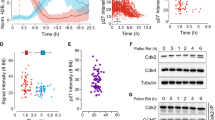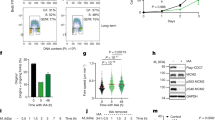Abstract
Continuing proliferation requires regulation of cyclin D1 levels in each cell cycle phase. Growth factors stimulate high levels during G2 phase, which commits the cell to continue through G1 phase with sufficient cyclin D1 to initiate DNA synthesis. Upon entry into S phase, however, cyclin D1 levels rapidly decline. Our goal is to understand the mechanism and importance of this S-phase suppression. Here, we demonstrate that cyclin D1 levels decline during S phase due to reduced protein stability, without alterations in the rate of protein synthesis. This decline depends upon Thr 286, since mutation of this site eliminates the normal pattern of cyclin D1 suppression during S phase. As evidence that phosphorylation of Thr 286 is responsible for this decline, Thr 286 is shown to be more efficiently phosphorylated during S phase than in other cell cycle periods. Finally, high cyclin D1 levels during S phase are shown to inhibit DNA synthesis. This inhibitory activity presumably blocks the growth of cells with altered cyclin D1 expression characteristics. Abnormal stimulation of cyclin D1 might result in levels high enough to promote G1/S phase transition even in the absence of appropriate growth stimuli. In such cells, however, the levels of cyclin D1 would presumably be too high to be suppressed during S phase, resulting in the inhibition of DNA synthesis.
This is a preview of subscription content, access via your institution
Access options
Subscribe to this journal
Receive 50 print issues and online access
$259.00 per year
only $5.18 per issue
Buy this article
- Purchase on Springer Link
- Instant access to full article PDF
Prices may be subject to local taxes which are calculated during checkout










Similar content being viewed by others
Abbreviations
- GSK3:
-
glycogen synthase kinase 3
- PI-3 kinase:
-
phosphatidylinositol-3 kinase
- Rb:
-
retinoblastoma
- GFP:
-
green fluorescent protein
- CDK:
-
cyclin-dependent kinase
References
Aktas H, Cai H and Cooper GM . (1997). Mol. Cell. Biol., 17, 3850–3857.
Alt JR, Cleveland JL, Hannink M and Diehl JA . (2000). Genes Dev., 14, 3102–3114.
Atadja P, Wong H, Veillete C and Riabowol K . (1995). Exp. Cell Res., 217, 205–216.
Bagui TK, Mohapatra S, Haura E and Pledger WJ . (2003). Mol. Cell. Biol., 23, 7285–7290.
Baldin V, Lukas J, Marcote MJ, Pagano M and Draetta G . (1993). Genes Dev., 7, 812–821.
D'Amico M, Hulit J, Amanatullah DF, Zafonte BT, Albanese C, Bouzahzah B, Fu M, Augenlicht LH, Donehower LA, Takemaru K, Moon RT, Davis R, Lisanti MP, Shtutman M, Zhurinsky J, Ben-Ze'ev A, Troussard AA, Dedhar S and Pestell RG . (2000). J. Biol. Chem., 275, 32649–32657.
Diehl JA, Cheng M, Roussel MF and Sherr CJ . (1998). Genes Dev., 12, 3499–3511.
Fukami-Kobayashi J and Mitsui Y . (1999). Exp. Cell Res., 246, 338–347.
Guo Y, Stacey DW and Hitomi M . (2002). Oncogene, 21, 7545–7556.
Han EK, Begemann M, Sgambato A, Soh JW, Doki Y, Xing WQ, Liu W and Weinstein IB . (1996). Cell Growth Differ., 7, 699–710.
Hitomi M and Stacey DW . (1999a). Curr. Biol., 9, 1075–1084.
Hitomi M and Stacey WD . (1999b). Mol. Cell. Biol., 19, 4423–4432.
Kelly BL, Wolfe KG and Roberts JM . (1998). Proc. Natl. Acad. Sci. USA, 95, 2535–2540.
Lukas J, Pagano M, Staskova Z, Draetta G and Bartek J . (1994). Oncogene, 9, 707–718.
Matsuoka S, Yamaguchi M and Matsukage A . (1994). J. Biol. Chem., 269, 11030–11036.
Matsushime H, Roussel MF, Ashmun RA and Sherr CJ . (1991). Cell, 65, 701–713.
Mittnacht S . (1998). Curr. Opin. Genet. Dev., 8, 21–27.
Pagano M, Theodoras AM, Tam SW, Draetta GF and Chen J . (1994). Genes Dev., 8, 1627–1639.
Sa G, Hitomi M, Harwalkar J, Stacey AW, Chen G and Stacey DW . (2002). Cell Cycle, 1, 50–58.
Sa G and Stacey DW . (2004). Exp. Cell Res., 300, 427–439.
Scovassi AI, Stivala LA, Rossi L, Bianchi L and Prosperi E . (1997). Exp. Cell Res., 237, 127–134.
Sewing A, Burger C, Brusselbach S, Schalk C, Lucibello FC and Muller R . (1993). J. Cell Sci., 104, 545–555.
Sherr CJ and Roberts JM . (1995). Genes Dev., 9, 1149–1163.
Solomon DA, Wang Y, Fox SR, Lambeck TC, Giesting S, Lan Z, Senderowicz AM and Knudsen ES . (2003). J. Biol. Chem., 278, 30339–30347.
Stacey DW . (2003). Curr. Opin. Cell Biol., 15, 158–163.
Woodgett JR . (2001). Sci. STKE (Electronic Resource): Signal Transduction Knowledge Environment, 2001, RE12.
Xiong Y, Zhang H and Beach D . (1992). Cell, 71, 505–514.
Acknowledgements
We thank Gaurisankar Sa for helpful suggestions throughout these studies. This work was supported by Grants CA9219 and GM52271 from the National Institutes of Health.
Author information
Authors and Affiliations
Corresponding author
Rights and permissions
About this article
Cite this article
Guo, Y., Yang, K., Harwalkar, J. et al. Phosphorylation of cyclin D1 at Thr 286 during S phase leads to its proteasomal degradation and allows efficient DNA synthesis. Oncogene 24, 2599–2612 (2005). https://doi.org/10.1038/sj.onc.1208326
Received:
Revised:
Accepted:
Published:
Issue Date:
DOI: https://doi.org/10.1038/sj.onc.1208326
Keywords
This article is cited by
-
Age- and cell cycle-related expression patterns of transcription factors and cell cycle regulators in Müller glia
Scientific Reports (2022)
-
DNA damage signaling guards against perturbation of cyclin D1 expression triggered by low-dose long-term fractionated radiation
Oncogenesis (2014)
-
Arsenic trioxide suppressed mantle cell lymphoma by downregulation of cyclin D1
Annals of Hematology (2014)
-
The role of β-adrenergic receptor signaling in the proliferation of hemangioma-derived endothelial cells
Cell Division (2013)
-
Mitosis-specific phosphorylation of amyloid precursor protein at Threonine 668 leads to its altered processing and association with centrosomes
Molecular Neurodegeneration (2011)



